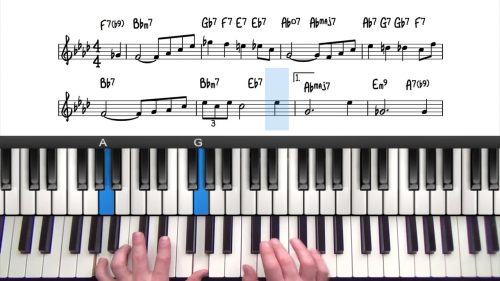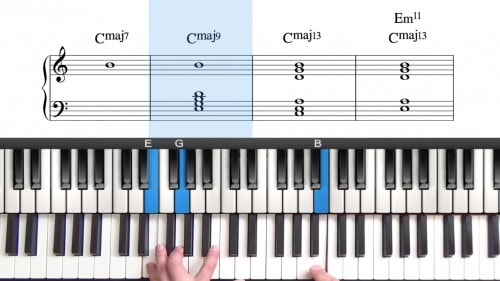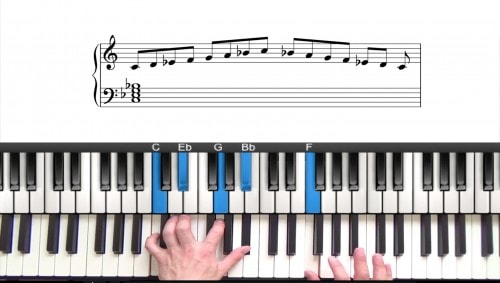White Christmas Jazz Piano Tutorial
In this lesson we create a jazzy Christmas arrangement for the song “I’m Dreaming Of A White Christmas”.
The tune is a ballad and is most commonly played in the key of C. We will be heavily reharmonising the changes to create a rich and harmonically complex arrangement.
On the chord changes download, there are multiple voicings options for most chords in the form. We start by playing the bottom set of chord symbols and then we will explore each reharmonisation in detail.
Lesson Downloads
-
“White Christmas” Audio File File Type: mp3
Practice Tips
-
Study the use of the pedal point in the final few bars.
-
Pedal points are often played over the root of the V7 chord.
-
In this example, we resolve to Cmaj7 in the final bar, and so we play the pedal point over a G bass.
-
This builds and releases tension in the final measures of the tune.








Fantastic what jazz can do to music. This lesson I think goes way to fast. To many opportunities and it makes it very confusing hayden. I think you are following a better structure when it comes to the trancripsion of the tunes in the other lessons. One step at the time. This is to advance teaching for me. Dint get me wrong I still think you are awesome and I have a lot of joy doing the other lessons but here I am kind of giving up before it starts.
Hi Jimmy 👋
Thanks for the feedback.
Some lessons do move faster through the theory than others. We try to cater for different levels of students and so in some lessons we may assume that the student has worked through the foundational material.
The Christmas songs in particular often are reharmonised heavily and so I can appreciate that it’s difficult to follow when just starting out.
My recommendation would be to work through the courses as outlined on our syllabus pages and that will equip you with all the foundational knowledge to understand the more advanced theory.
Cheers!
Hayden
Hey Hayden!
I don’t see an mp3 of your playthrough of this song. Do you have that available, please?
Thank you!
Hi Theo 👋🏻
I have added the playthrough as a download.
Check out the Downloads Section above.
Any issues with the file let me know.
Cheers and have fun with these songs!
Hayden :–)
Many thanks!
Love your version, the only thing I am missing is that high C in the second to last line “may your days be merry and *bright*” where you are opting to shift down, but maybe an opportunity at a first try of finding my own chord for that ;)
Hi Phillip,
Thanks for the comment and I’m glad you like the arrangement
Yes it’s a good idea to try to make these arrangements your own by switching up certain chords and experimenting with different voicings.
You might like to check out my seminar here where we talk about reharmonising jazz standards:
pianogroove.com/live-seminars/how-to-reharmonise-melody/
In that seminar we take the tune “I’ll Be Home For Christmas” and we explore a range of different reharmonisation techniques. I think you will enjoy it.
Check out that seminar and let me know if you have any other questions.
Cheers,
Hayden
Hi Hayden
Some of this re harm still feels confusing as I’m still tryin to learn the tune in its more basic form. Question when I see your lead sheet with the chords written above the original, those are replacement/alternatives to the chord below?
I think I tend to get a head of myself because I hear all these cool alternative chords and end up plunking around with the notes by ear within the basic chords and often don’t learn to play the tune smoothly.
Best,
Eric
Hi Eric,
Firstly, this tune is tricky to play and arrange in a jazz style without reharmonising it significantly and so it’s normal to find these chord changes unusual and difficult to follow. Some tunes are simply better suited to jazz reharmonisation than others.
Yes when I stack chords on top of each other, I am simply showing alternate chords or sequences of chords which work with the given melody. Usually I would either play either the top line, or the bottom line. Sometimes it might be possible to combine them but generally I am showing 2 different ‘routes’ for navigating the harmony and melody.
For example, in bars 6 and 7, I would either play the top line which is:
F#m7b5 to B7 to Em7 (251 in E minor) to Eb7 to D-11
alternatively I could play the more standard changes which are indicated on the bottom line:
G7b9 to Cmajor to G7sus G7
For virtually all of my reharmonisations here, and when I’m reharmonising in general, there will typically be some kind of V to I relationship at play (such as 25 or 251 progressions) and often using tritone relationships where we have chromatic dominant chords.
Remember that any dominant chord wants to resolve a 5th below, or a half step down.
I hope that helps Eric – and let me know if you have any other questions!
Cheers,
Hayden